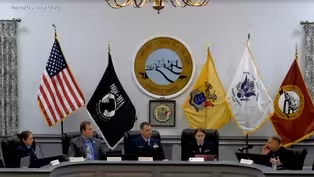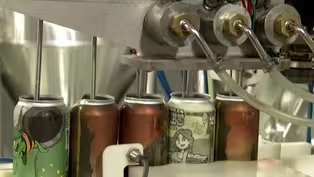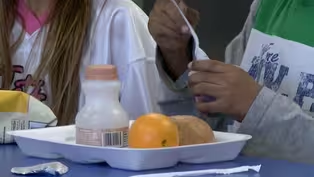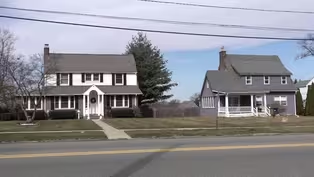NJ Spotlight News
Study examines extent of plastic particles in bottled water
Clip: 1/16/2024 | 4m 37sVideo has Closed Captions
Interview: Phoebe Stapleton, Rutgers University, co-author of the study
In a new study by researchers at Rutgers and Columbia universities, high amounts of plastic particles were found in bottled water. On average, one liter of water contained around 240,000 detectable plastic fragments, 10 to 100 times greater than previous estimates.
Problems playing video? | Closed Captioning Feedback
Problems playing video? | Closed Captioning Feedback
NJ Spotlight News is a local public television program presented by THIRTEEN PBS
NJ Spotlight News
Study examines extent of plastic particles in bottled water
Clip: 1/16/2024 | 4m 37sVideo has Closed Captions
In a new study by researchers at Rutgers and Columbia universities, high amounts of plastic particles were found in bottled water. On average, one liter of water contained around 240,000 detectable plastic fragments, 10 to 100 times greater than previous estimates.
Problems playing video? | Closed Captioning Feedback
How to Watch NJ Spotlight News
NJ Spotlight News is available to stream on pbs.org and the free PBS App, available on iPhone, Apple TV, Android TV, Android smartphones, Amazon Fire TV, Amazon Fire Tablet, Roku, Samsung Smart TV, and Vizio.
Providing Support for PBS.org
Learn Moreabout PBS online sponsorshipresearchers are offering a reality check on the bottled water you pick up at the grocery store it turns out a standard siiz bottle can contain up to a hundred times more plastic particles than previously thought a new study published by scientists at ruter and Columbia University found one liter of water contained some 240,000 tiny plastic fragments they're known as nanoplastics which researchers say could be even more dangerous than the microplastics found vir everywhere I recently asked the co-author of the study Dr Phoebe Stapleton of ruter University what that means for your health Dr Stapleton it's great to have you on the show let me just start with the basics here because these findings are pretty significant What specifically did you find uh on average with these nanoplastics when looking at uh water yes so previous studies had looked at microsized plastic itics in bottled water and we uh were able to take one step further with this technology to look at nanosized Plastics as well they're about a thousand times smaller than the microsized Plastics we were able to confirm the microsized plastic findings but also identify about a quarter of a million on average nanosized Plastics within a liter of bottled water so is this new meaning did we know that nanoplastics existed before because of course we've um had research for years about the microplastics in water so we as scientists kind of I guess had that gut feeling or knew that they should be there but having the tools and the methodology to be able to not only quantify them but identify the chemistry of what type of particles was there was new because of course they're invisible you can't see them in the air you can't see them in the water in one it was pretty clear that it's likely coming from the packaging itself the bottle or the capping that process of it but from the other two the greatest percentage was not that type of plastic so it was either coming we theorize may have been in the filtering process of the water or as you say from The Source water itself you all didn't list those brands of water that you tested I'm guessing that's for reason but for those who do drink bottled water and there's virtually none Among Us who haven't at one point um what are the health implications if any that we should be concerned about so you're right we didn't list the the U types of water that it was or the brands uh but they were commercially available products and the health effects are still under investigation um we know that these nanosiz Plastics are of Greater concern because they're able to breach biological barriers they're able to get through the GI system they're able to get through the lung as well and um translocate or move to other tissues in the body and then then the question that we have in our laboratory in particular is what are those effects once those nanosized Plastics get to those other tissues like the liver or in our particular case the placenta so not that this is your place to say but what should be done with this information both from the consumer side and then also you know for folks who are in the policymaking position yeah so this work is really Landing in that awareness category because like we talked about at the beginning something that you can't see but now we can confirm that they are indeed there so I think bottled water definitely has its place if the water that is in a community isn't safe for lead for example or natural disaster then we need to rely on bottled water in those cases I think if you have the chance to reduce plastic intake since we don't know what the health effects are yet I think that's a good decision so reducing bottled water use not only reduces the chance of this ingestion but also reduces that single use risk as well I think at the moment we're just ahead of the game for policy makers and regulation that we we know that they're there and I'm not sure it's wise to wait for all of the health effects before we start to wonder if they should be there it's good advice no doubt Dr Phoebe Stapleton is a professor of pharmacology and toxicology at ruter University thank you so much thank you for your time thank you for having me [Music]
Former Gov. Codey reflects on decades of service in Trenton
Video has Closed Captions
Clip: 1/16/2024 | 8m 13s | Codey spent 50 years in state politics (8m 13s)
How poor communications hindered Port Newark fire rescue
Video has Closed Captions
Clip: 1/16/2024 | 4m 29s | Federal hearing into the fatal cargo-ship fire continues on Wednesday (4m 29s)
Murphy signs bill that eases restrictions on breweries
Video has Closed Captions
Clip: 1/16/2024 | 1m 7s | The law will also boost the number of liquor licenses in NJ (1m 7s)
New law expands access to free school meals
Video has Closed Captions
Clip: 1/16/2024 | 1m 35s | Around 60,000 more kids will qualify under law Gov. Phil Murphy signed Tuesday (1m 35s)
NJ gets first statewide snowfall in nearly two years
Video has Closed Captions
Clip: 1/16/2024 | 1m 18s | Most places got between 1 and 3 inches of snow (1m 18s)
NJ to target appraisers who undervalue Black-owned homes
Video has Closed Captions
Clip: 1/16/2024 | 4m | AG creates task force to investigate cases of alleged bias (4m)
Providing Support for PBS.org
Learn Moreabout PBS online sponsorshipSupport for PBS provided by:
NJ Spotlight News is a local public television program presented by THIRTEEN PBS

















